Kennelly, M., O'Mara, J., Rivard, C., Miller, G.L. and D. Smith 2012. Introduction to abiotic disorders in plants.
The Plant Health Instructor. DOI: 10.1094/PHI-I-2012-10-29-01
Megan Kennelly1, Judith O'Mara1, Cary Rivard1, G. Lee Miller2, Damon Smith3
1Kansas State University, 2University of Missouri, 3University of Wisconsin-Madison
Introduction
Plants can be damaged by infectious microbes such as fungi, bacteria, viruses, and nematodes. They can also be damaged by noninfectious factors, causing problems that can collectively be termed "abiotic diseases" or "abiotic disorders". For the purposes of this article we will refer to them as abiotic disorders. Unfavorable soil properties, fertility imbalances, moisture extremes, temperature extremes, chemical toxicity, physical injuries, and other problems are examples of abiotic disorders that can reduce plant health and even kill plants. Furthermore, many of these abiotic disorders can predispose plants to diseases caused by infectious microbes. Biotic and abiotic plant diseases can be compared to infectious and non-infectious human diseases. In humans, the flu virus and streptococcal bacteria cause infectious diseases, and they spread from person to person. In contrast, non-infectious (abiotic) disorders in humans include health conditions which are not transmitted from person to person or caused by an infectious agent. For example, vitamin A deficiency can cause blindness, vitamin C deficiency can cause scurvy, excessive dietary cholesterol can cause many health problems, and exposure to mercury or lead is toxic.
Abiotic disorders in plants are very common. In the experience of the authors and many of our peers, about half of the plant samples that arrive in plant diagnostic clinics suffer from abiotic disorders. It is critical to understand abiotic disorders to more fully understand plant health.
This lesson describes a number of common abiotic disorders in plants. Keep in mind that multiple abiotic problems may contribute to plant decline, and both abiotic disorders and biotic diseases often occur on the same plants.
Soil Factors – Physical Properties and pH
Soil Structure
Soil structure determines the soil's ability to hold water, nutrients, and oxygen and make them available to plants. The most common issue related to soil structure is compaction, which results in inadequate pore space for root growth. Clay soils, with their smaller particle size, have naturally smaller pore space and are at high risk for becoming severely compacted. Compaction can occur from a variety of sources including traffic (particularly heavy farming or construction equipment) (Figure 1), raindrop impact, tilling operations (plow layer), and minimal crop rotation. Reduced water availability is an obvious consequence of compaction as runoff occurs more frequently in a compacted soil and available pore space to hold water is limited. However, low oxygen availability for root respiration can also be a serious consequence of restricted soil pore spaces. Although some plant species are more tolerant of the consequences of compacted soils than others, if the problem is severe, all plants in the compacted area will be affected. If compaction is suspected, use a spade to check for resistance of underlying soil. Many compacted soils are 2:1 shrink-swell clays (smectites), so cracking at the soil surface during dry periods can be an indication of compaction. Conversely, water pooling in low spots after a precipitation event could indicate reduced infiltration resulting from an underlying compacted soil.)
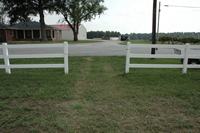 Figure 1
Figure 1 Soil pH
Soil pH is the measure of the H+ ion activity in the soil solution. A high amount of H+ activity results in an acidic soil condition, while low activity results in a predominance of OH- activity, leading to alkaline soil. Although some plant species have preferences for more extreme acidic or alkaline soil conditions, it is generally regarded that a slightly acidic pH range of 6-7 is most favorable for plant growth. Soil pH outside of this range can have a dramatic impact on the solubility and therefore availability of plant nutrients. Soil pH below 5.5 generally results in low availability of calcium (Ca), magnesium (Mg), and phosphorus (P), and increased solubility of aluminum (Al), iron (Fe), and boron (B). High levels of these three nutrients in low soil pH are common, and can induce toxicity symptoms in plants. Soils with pH levels above 7.8 have a high availability of Ca and Mg at the expense of P, B, Fe, manganese (Mn), zinc (Zn), and copper (Cu). Plants grown in these alkaline soils often have deficiency symptoms to these nutrients (Figure 2A-E).
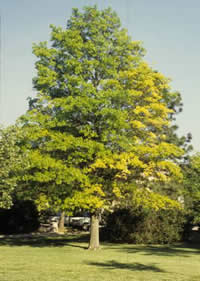
Figure 2A |
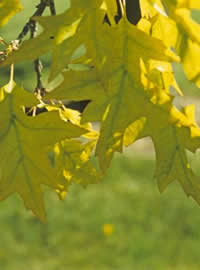
Figure 2B |
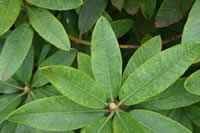
Figure 2C |
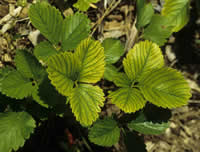
Figure 2D |
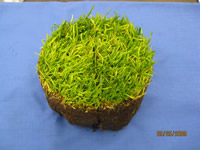
Figure 2E |
In most cases, low soil pH can be adjusted to a more alkaline condition prior to planting with the application of calcium carbonate (limestone). Due to the immobility of the material, tilling limestone into the top 4-6 inches will result in greater pH adjustment. If soil pH is too alkaline, sulfur (S) can be incorporated in the same manner for pH reduction. Nitrogen (N) fertilizer sources can also impact soil pH due to the role of ion exchange at the root surface. Ammonium forms of N tend to reduce soil pH while nitrate forms will cause a soil pH increase (Figure 3A-B). Similarly, ammonium sulfate fertilizer is commonly used to reduce soil pH, particularly for crops that prefer these conditions. Soilborne pathogens, as well as plants, prefer certain pH ranges. Changing fertilizer N source can sometimes suppress soilborne disease as it changes the pH of the soil near the root surface, thereby changing the environment where infection occurs. Although this strategy can be successful under some circumstances, changing the bulk soil pH using fertilizer alone can be difficult. If a large change in soil pH is desired, soil tests should be conducted to determine how much limestone or S should be incorporated to reach the desired soil pH.
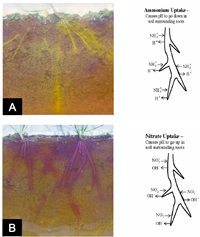 Figure 3A&B
Figure 3A&B Fertility – Excesses and Deficiencies
Nutrient Toxicities/Excesses
Damage from excessive macronutrient levels can occur in crop and ornamental plants as the result of over-application of fertilizers or manures (Figure 4). Nitrogen toxicity is most typical under hot, dry conditions and plants turn an overly-deep shade of green. Lesions often occur on the stems of annual seedlings and these can be confused with canker diseases. Similarly, twisting and distorting of mature tomato plants that experience ammonium toxicity may appear similar to symptoms caused by viruses. Ammonium toxicity can be a problem in greenhouse soils because of the lack of specific microorganisms that convert ammonium to nitrite and then to nitrate.
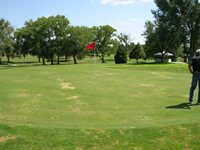 Figure 4
Figure 4 Micronutrient toxicities are common in many production systems. Symptoms often include chlorosis or necrosis on leaf margins or tips (Figure 5), but leaf spotting, flecking, and other symptoms can occur. As noted above, many nutrient toxicities are triggered by excessively low or high soil pH. Micronutrient toxicities are particularly common in greenhouse floriculture. For example, Fe and Mn toxicity often occurs in greenhouse crops when the growing medium has a low pH. Excessive micronutrients can also occur when irrigation water or soil has significant concentrations of micronutrients.
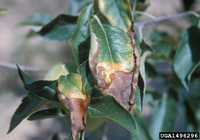 Figure 5
Figure 5 Other elements that are not plant nutrients, e.g., lead (Pb) and arsenic (As), and heavy metals can also be toxic to plants.
Nutrient Deficiencies
Nutrient deficiencies often result from a lack of plant nutrients in the soil (Table 1). However, as noted above, certain nutrient deficiencies, such as Ca, P, and Fe, occur due to poor soil conditions (such as inappropriate soil pH) for nutrient uptake and utilization by the plant. Two of the easiest ways to recognize nutrient deficiencies are the lack of visible pathogen signs (infectious microbe parts, such as mycelium) and the relatively uniform distribution pattern of symptoms in the field as compared to many diseases caused by plant pathogens. However, plant nutrient deficiencies are best diagnosed using plant tissue analysis. As opposed to soil nutrient analysis, plant tissue analysis allows one to determine plant nutrient uptake rather than plant nutrient availability. Because nutrient deficiencies lack visible signs, they are often mistaken for virus diseases. One of the best ways to diagnose nutrient disorders is the distribution of symptoms on the plant. Mobile nutrients are readily transferred within the plant to the growing points so symptoms appear on the lower (older) leaves of the plant. Conversely, immobile nutrients display symptoms on the meristem of the plant during nutrient deficiencies.
Table 1. A list of some essential plant nutrients (elements) and their relative importance and mobility in plants
Plant Nutrient | Macro/Micro | Mobility | Comments: |
Nitrogen (N) | Primary Macro- | Mobile | Easily leached |
Phosphorus (P) | Primary Macro- | Mobile | pH strongly affects |
Potassium (K) | Primary Macro- | Mobile | Fruit quality |
Calcium (Ca) | Secondary Macro- | Non-mobile | Excess can limit others |
Magnesium (Mg) | Secondary Macro- | Mobile | Leach if Ca not present |
Sulfur (S) | Secondary Macro- | Non-mobile | Sulfur may acidify soil |
Boron (B) | Micronutrient | Non-mobile | Remedy with borax |
Copper (Cu) | Micronutrient | Non-mobile | Deficiency rare |
Iron (Fe) | Micronutrient | Non-mobile | pH strongly affects |
Manganese (Mn) | Micronutrient | Non-mobile | Absorbed via leaves |
Molybdenum (Mo) | Micronutrient | Non-mobile | Important for legumes |
Zinc (Zn) | Micronutrient | Non-mobile | High pH leads to deficiency |
Nitrogen (N) deficiency is a major limitation for non-leguminous agricultural plants, and use of N fertilizer for crop and ornamental plants is higher than any other single macro- or micronutrient. Nitrogen is important for the production of chlorophyll, the pigment that makes plant tissues green. Plants deficient in N typically have a pale yellow color (chlorosis) as a result of reduced chlorophyll production (Figure 6A-B). Nitrogen is also a vital element for many other plant physiological processes as a component of proteins. Therefore, plants that are deficient in N may also appear stunted and display poor vigor. Because N is highly mobile in the plant, N deficiency is usually observed first in the older leaves of the plant. These older leaves may senesce while younger shoots near the apical meristem remain healthy. Nitrogen deficiencies are common in non-legume crops because N is quickly leached out of the soil once it is converted into NO3- by soil microbes. Plants can absorb N in two ionic forms, NO3 and NH4. Soil amendments that are commonly used to provide N to plants include a variety of synthetic fertilizers in addition to cover crops and compost applications. Nitrogen deficiencies may also result from infection by root pathogens such as root-knot nematodes (Meloidogyne spp.). Nitrogen deficiencies can cause increased susceptibility to certain leaf pathogens such as
Alternaria solani, while excessive plant N levels may result in increased susceptibility to other pathogens such as
Botrytis cinerea, or
Rhizoctonia solani.
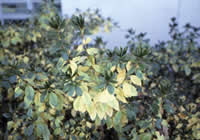
Figure 6A |
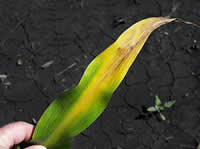
Figure 6B |
Phosphorus (P) deficiency can be a serious problem in some plants because it is typically not very mobile in soils. In addition, certain environmental conditions can make it difficult for plants to absorb and translocate this macronutrient. Phosphorus is utilized in the plant for a number of activities including photosynthesis, the transport of energy (in the form of ATP) throughout the plant, and as an important component of DNA. Phosphorus is also important for flowering and seed production. Plants deficient in P have weaker stems, which can result in problems such as lodging in grain crops. Phosphorus deficiency can also result in poor growth and stunting, a blue/green hue to the leaves, and/or purple-colorations to stems and undersides of the leaves (Figure 7A-B). Soil type and biological characteristics greatly affect P availability in soil. Plants grown in acid and clay soils are particularly prone to P deficiency. Cool conditions or poor oxygen availability to the roots can lead to P deficiency. Phosphorus can be supplied to soils as commercial fertilizers, natural rock materials or animal residues.
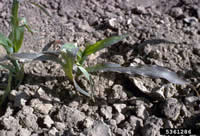
Figure 7A |
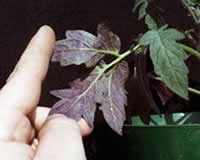
Figure 7B |
Iron (Fe) deficiency (chlorosis) is a significant problem for crop and ornamental plants, particularly in calcareous and high pH soils. Iron chlorosis is prevalent in some areas of the US on tree and landscape species as well as turfgrasses. Iron is a key component in the production of chlorophyll within the leaf. Therefore, plants with an Fe deficiency typically have similar leaf size/shape compared to normal plants, but will display interveinal chlorosis (Figure 2A-E). Symptoms first develop in the new growth which appears as yellow-green leaves, often with a striped appearance. Most soils have adequate supplies of Fe, but availability to the plant decreases as soil pH increases. Maintaining pH <7 is critical to optimize availability of Fe for plants. Iron deficiencies can also occur when soil oxygen availability is low, such as heavily compacted areas. Iron availability can also be affected by soil microbial activity and can therefore be reduced during low temperatures, low light conditions, and wet or excessively dry soils.
Potassium (K) deficiency arises in the older leaves of the plant. Potassium deficiency can be particularly important in certain fruit and vegetable production systems for its role in fruit quality. Potassium plays a key role in cellular signaling and growth regulation in plants. It also functions in other processes such as photosynthesis. Symptoms of K deficiency include necrosis (tissue death) on leaf margins, leaf curling and browning, and interveinal chlorosis (Figure 8A-C). Plants that are deficient in K can be more prone to frost damage as well as certain diseases. Potassium is found in large quantities throughout soils. However, due to soil parental material and the effect of weathering, soil K levels vary significantly. Potassium availability is reduced by the presence of competing cations such as Ca)2+ and NH4+. Potassium can also be readily leached from sandy soils. Plant uptake of K may be reduced by certain environmental conditions including temperature, soil moisture, and oxygen availability. Potassium can be applied in conventional fertilizers or with rock phosphate (potash).
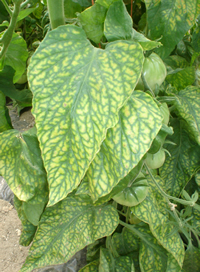
Figure 8A |
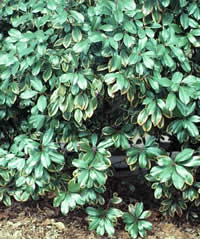
Figure 8B |
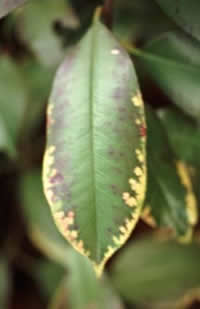
Figure 8C |
Calcium (Ca) deficiency occurs in many fruiting vegetables and can be a severe problem in acid soils. Calcium deficiency can be a result of inadequate levels of Ca within the soil or growing medium, but it is often the result of poor transpiration or fluctuations in soil moisture levels. Calcium is necessary for plant growth and in particular is an important component in the production of cell walls. Calcium is also important as a signal regulator and serves to strengthen cell membranes. Blossom end rot is a common symptom of Ca deficiency on fruits (Figure 9A). Other symptoms manifest as plant stunting, localized tissue necrosis, and leaf marginal chlorosis (Figure 9B). Blossom end rot and other fruit disorders caused by Ca deficiency (e.g., bitter pit of apples) can often lead to secondary colonization by fungi. Death of terminal buds and root tips can occur and root growth is often inhibited. Because Ca2+ is highly immobile, mature older leaves are typically unaffected and symptoms are pronounced in the growing tissues. Calcium deficiency can be overcome by raising pH (in acid soils) and applying Ca fertilizer. Calcium is also available via additions of calcitic lime and gypsum. Calcium has long been studied in its relationship to plant disease and plant pathogenesis. Due to its role in strengthening cell walls, Ca deficiencies may lead to increased susceptibility to certain plant diseases. Similarly, Ca is a component of host response proteins to pathogen toxins, such as oxalic acid, which is utilized by some fungi such as
Sclerotium rolfsii during infection.
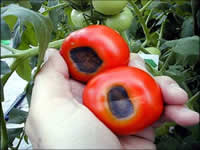
Figure 9A |
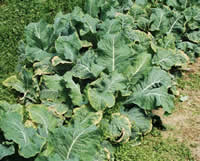
Figure 9B |
Magnesium (Mg) deficiency can occur in alkaline soils, but is most prevalent in strongly acidic, sandy soils where Mg can be easily leached away. Magnesium is an important component of the chlorophyll molecule and is an important cofactor in the production of ATP. Plants that are Mg-deficient display interveinal chlorosis and have reduced photosynthesis. Magnesium deficiency is often mistaken for K deficiency due to similar plant symptoms. Magnesium deficiency results in chlorotic and necrotic tissues with an orange, red, or brownish color (Figure 10A). Yellowing of the leaf margin is also common on many plant species. Early leaf senescence may also occur, particularly on older leaves as Mg is easily translocated through the plant (Figure 10B-C). Over-application of K and/or Ca,which competes at soil cation exchange sites, can also lead to Mg deficiency. Similarly, over-application of Mg can lead to Ca deficiency; it is important to maintain a suitable Ca:Mg ratio in agricultural soils. Magnesium deficiencies are often confused with viruses and other nutrient problems. However, symptoms of viruses are typically manifested in the young, growing part of the plant. Foliar and granular applications of Epsom salt can be used to remedy Mg deficiency in crop plants.
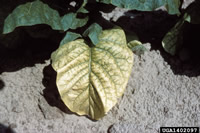
Figure 10A |
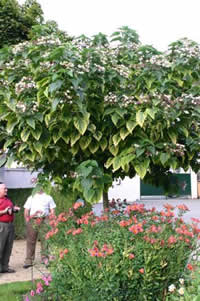
Figure 10B |
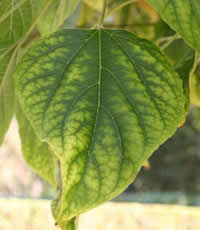
Figure 10C |
Moisture extremes
Water is an important requirement for growth and survival of plants. Water needs of plants can vary greatly based on the species and environment. If water requirements are not adequately met for any given species, the plant's physiology and biochemistry are affected. Both water deficiency and excess can cause injury to plants. Sometimes the injury is short-lived (acute; several hours) or long-lived (chronic; days or weeks). Plants may recover from short-term injury, but as the duration increases, the likelihood of recovery decreases due to sustained negative effects on overall plant function and growth.
Diagnosis of water status problems can be difficult. Low water status or excessive amounts of water can cause plant symptoms easily confused with injury from other sources such as salt or herbicide. Certain infectious diseases such as root-rot (e.g.,
Phytophthora spp.) and vascular wilt (e.g.,
Ophiostoma ulmi) also cause similar symptoms such as wilting. Available soil moisture should be evaluated. A soil test might be necessary to rule out high levels of salt, or other soil nutrient issues that could result in the observed symptoms. If soil appears to be excessively wet, is discolored, or smells strongly of rotten eggs, water drainage in the area should be addressed. If there is an irrigation system, this should be checked for proper functionality. Inspect roots for evidence of damage or rot by plant pathogens. Pathogen structures such as mycelium and fruiting structures are rare and difficult to observe in many root rots, and plant samples should be collected and sent to a reputable diagnostic lab for analysis.
Deficiencies in Available Water
Low water status in plants can occur either as a short-term or chronic deficiency. A short-term deficit of water might result in only minor effects on the plant such as wilted leaves or shoots (Figure 11). These symptoms may be temporary and occur during the warmest part of the day when transpiration rates are highest. Once the environmental stresses are relieved (i.e., air temperature declines, supplemental irrigation is applied, a rain event occurs, etc.) the symptoms of low water status may disappear.
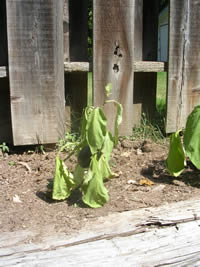 Figure 11
Figure 11 During chronic periods of water deficit, the injury sustained by plants may be more severe. Plants may grow more slowly or not at all, young leaves may not fully expand, or foliage may not appear as colorful relative to foliage when the plant is not under low water stress. In severe cases "scorching" or marginal leaf necrosis can occur on deciduous trees (Figure 12A-B) and needle necrosis can occur on conifers (Figure 13).
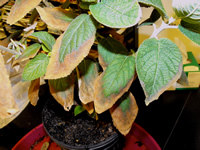
Figure 12A |
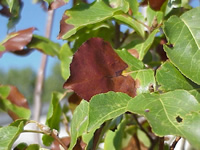
Figure 12B |
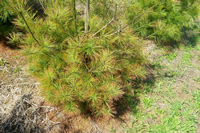
Figure 13 |
During winter months when rain or snowfall might be scarce, or if soil is frozen for an extended period of time, plant roots may not be able to absorb water. If windy and/or sunny days prevail, water loss from foliage can continue because of lack of water uptake by roots. The result is winter desiccation, in which the foliage might appear off-color, "scorched", or necrotic (Figure 14).
 Figure 14
Figure 14 Excessive Quantities of Water
Excessive soil moisture can result in reduced oxygen availability to roots. Oxygen is a principal component for the physiological uptake of water into the roots. Therefore, similar to drought, a primary symptom of flooding is plant wilt. Also similar to low water status, excess soil moisture can manifest as acute or chronic. During acute water excess (flooding), roots are subjected to low oxygen status and cell weakening and/or death occurs. Symptoms include discolored and/or water-soaked and mushy roots. Under these conditions roots can become weakened and predisposed to invasion by pathogens such as
Phytophthora spp. Flooding events also predispose plants to root diseases caused by certain pathogens that have flagella to swim towards host roots. Conversely, anaerobic and low-oxygen conditions can be detrimental to nematode populations. A new area of research in soilborne disease management utilizes highly anaerobic conditions to disinfest soils in raised-bed vegetable and fruit production prior to planting of the crop.
In the case of chronic excess of water, plants appear stunted and have underdeveloped shoots. In severe cases bleeding cankers on stems can occur. Adventitious roots may form at the root crown. Bark can split and wood may become water-soaked and discolored. Edema or corky, blister-like swelling can occur on the underside of leaves on plants growing in waterlogged soils. Edema can be worse during cloudy, overcast periods. In areas where waterlogged soils prevail for long periods of time, an odor of rotten eggs may be noticeable, due to sulfur gas production in the anaerobic soil.
Temperature Extremes
Excessively high or low temperatures can be detrimental to plants. The injury and severity sustained by plants as a result of temperature extremes will vary depending on plant species or age, the duration of the temperature event, the time of year, or the interaction with other stresses. Interestingly, because of the environmental conditions in which they live, roots and aboveground biomass may have varying levels of tolerance to thermal stress. Shoots tend to experience wider ranges of air temperatures whereas roots may be exposed to soil temperature extremes over longer periods of time.
High Temperature Damage
Some plant species can be very sensitive to high temperatures. In plants adapted for cooler climates, physiological changes can result in response to excessively high temperatures. For example, shoots and/or roots may stop growing if high temperatures prevail for an extended period of time. Roots may die. If high temperatures are coupled with low soil moisture, plants may exhibit scorching on the margins of the leaves, premature leaf drop, and in severe cases entire plant death. Sometimes physiological changes result in abnormal color or growth habits. For example, when geraniums (Pelargonium spp.) are subjected to temperatures above 95°F (35°C), newly forming leaves may become "bleached" or white in color (Figure 15). Another common occurrence is the effect of high temperatures on pollination. Many food crops species are highly subject to poor pollination during periods of high temperatures.
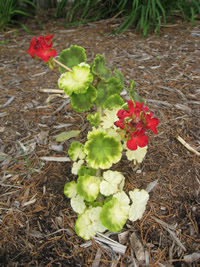 Figure 15
Figure 15 Low Temperature Damage
Damage from low temperatures generally develops because ice crystals form in plant cells resulting in damage to cell membranes and organelles. Dehydration or low water status can also occur as a result of low temperatures. Many plants native to tropical regions can be injured by chilling injury (e.g., damage occurs above 32°F; 0°C) and killed if sub-freezing temperatures occur for long periods of time. Other plants may be better adapted for cold environments and not experience damage until temperatures are at or below freezing (32°F; 0°C). For example, bermudagrass is adapted for the southern zones of the United States but slightly farther north bermudagrass has an extended period of winter dormancy but also can be killed due to sustained sub-freezing winter temperatures (Figure 16).
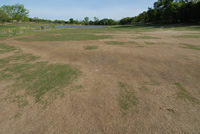 Figure 16
Figure 16 Low-temperature injury can vary depending on the time of year and plant species. Newly expanding shoots are more sensitive than mature plant parts. If freezing temperatures are encountered after spring bud break, shoots can be severely injured or even killed. Chilling temperatures (above 32°F; 0°C) can damage newly expanding plant parts, resulting in a purplish coloration of foliage and possible necrosis. Woody parts of plants can also be injured by sub-freezing temperatures. Bark can crack, thereby exposing underlying wood to attack by pathogens or insects. Bark cracking from freezing injury greatly increases the susceptibility to infection by pathogens such as
Agrobacterium tumefaciens, which causes crown gall on many ornamentals (Figure 17). Cold temperatures combined with freezing rain can also result in ice accumulation on limbs of woody plants, which can cause severe breakage – see )Mechanical Damage below.
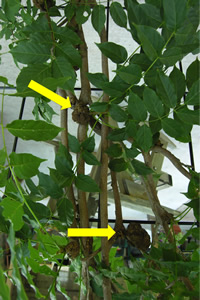 Figure 17
Figure 17 Low-temperature injury can often be mistaken for infectious root disease, chemical injury, or gas injury. Plant managers should practice patient observation to determine the extent of the injury. Once determined, careful pruning may be necessary to remove damaged plant parts. If severe damage is sustained by extreme temperature (high or low), removal and replacement of the plant with a hardier species might be warranted.
Chemical Injuries (Phytotoxicity)
Numerous agricultural chemicals are used in plant production and maintenance – herbicides, insecticides, fungicides, and plant-growth regulators. Always read the pesticide label before use. These materials are applied to protect plants from pests and improve plant health, but exposure to inappropriate products, overly high rates, or certain product mixtures can cause severe problems. When using a material or a mixture for the first time it is best to test on a small scale first.
Herbicides
Herbicides are used to control weeds, but exposure to non-target plants can be devastating. Herbicides may be non-selective, affecting all plants, or selective, affecting certain plant groups (e.g., broad-leaf plants or grasses). They may be even more selective within those groups. Herbicide modes of action vary and include plant growth regulation (hormone mimics), amino acid-biosynthesis inhibitors, lipid-biosynthesis inhibitors, membrane disruptors, and respiration inhibitors. These modes of action can affect photosynthesis, root growth, shoot growth, and other aspects of plant growth.
Some herbicides cause root stunting or swelling, and could be confused with damage from nematodes. Others herbicides cause necrotic/chlorotic spots or blotches that could be confused with a foliar disease (Figure 18A-B). Some herbicides cause mottled colors, distortion or vein banding that could be confused with a viral disease. For example, the phenoxy herbicide 2-4D, a synthetic auxin, causes distortion in grapes (Figure 19A), cotton (Figure 19B), tomatoes (Figure 19C), and many other plants, which could be confused with a virus disease. Diuron can cause discoloration along the veins in grapevine which could be confused with a virus disease or a nutritional problem (Figure 19D).
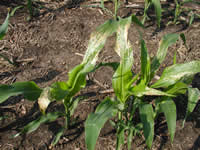
Figure 18A |
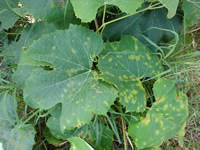
Figure 18B |
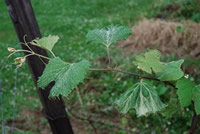
Figure 19A |
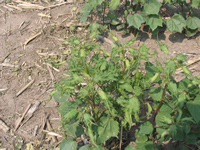
Figure 19B |
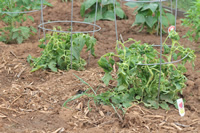
Figure 19C |
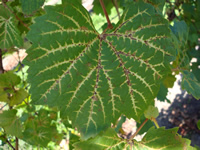
Figure 19D |
If herbicide injury is suspected, find out what material was applied, the rate, and when -- both during the season of interest and in the prior year. Some herbicides can have long residual effects in the soil and cause damage to rotational crops in subsequent seasons (Figure 20). Furthermore, some herbicides have recommended intervals to wait before planting to a susceptible species, and this interval can vary depending on weather conditions or soil factors. If herbicide drift is suspected, find out what has been used on neighboring properties or along nearby roadside rights-of-way. Check weeds for symptoms – drift is sometimes apparent in weeds in addition to the non-target plant. Soil or plant tissue analysis can be conducted to help determine whether herbicides were involved in the injury.
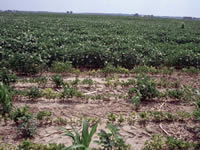 Figure 20
Figure 20 Fungicides and Insecticides
While fungicides and insecticides are designed to protect plants from diseases and arthropod pests, inappropriate rates or tank-mixes can cause problems. Some fungicides have well-documented phytotoxic effects. Copper materials can cause tissue bronzing (Figure 21A). Some cultivars of certain crops, such as grapes, are particularly sensitive to copper or S (Figure 21B-C). Mixtures of some pesticides can cause damage, such as combining captan or sulfur with certain oils, especially in hot weather (Figure 21D). Fungicide labels and extension publications often mention known incompatibilities.
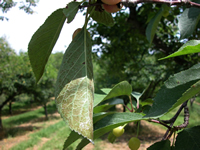
Figure 21A |
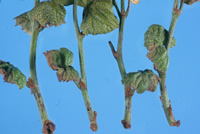
Figure 21B |
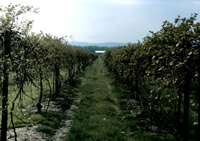
Figure 21C |
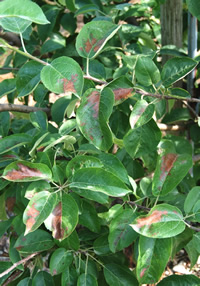
Figure 21D |
Plant Growth Regulators
Plant growth regulators (PGRs) are chemicals that alter the physiology of plants, affecting flowering, elongation, root growth, and other functions. They are utilized in the production of many types of crops. For example, in some fruit crops, PGRs are used to reduce vegetative growth, thin fruit to appropriate levels, and improve fruit quality. In ornamentals, gibberellin inhibitors are applied as foliar sprays or substrate drenches to reduce shoot elongation, making plants stronger, more compact, and of overall higher quality. In turfgrass, cell elongation inhibitors are used to reduce mowing frequency, and cell division inhibitors are used to reduce seedhead production.
Unfortunately, PGRs also can have negative effects. For example, foliar applications of chlormequat chloride, a gibberellin inhibitor, can cause temporary chlorosis in ornamentals (Figure 22A). If applied at the wrong rate, the wrong time, or under certain environmental conditions (e.g., high light or high temperature), the consequences can be severe, with long-lasting discoloration, stunted growth, or other symptoms (Figure 22B). Certain fungicides also have negative growth-regulating effects, which may be stronger in particular species or cultivars, or more severe in hotter weather.
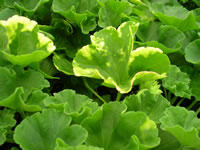
Figure 22A |
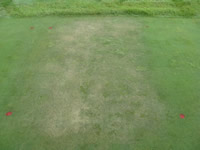
Figure 22B |
De-icing Salts
De-icing salts used to lower the melting point of ice on roadways and sidewalks can cause significant damage to surrounding trees, lawn, and landscape plants (Figure 23A-C). For example, sodium chloride salt (NaCl) separates into sodium (Na) and chloride (Cl) when dissolved in water, both of which are toxic to plants in high amounts. Sodium impacts nutrient availability (particularly Mg and K) by competing at the root exchange sites. The disassociated chloride ion is also taken up by plants and accumulated in leaves where it can reach toxic levels. Salt absorbs water and also changes the osmotic potential of the soil solution so that water flows out of the root instead of in. A "burn" symptom is the result of the combination of these factors, and is generally noted as a chlorotic scorch symptom of leaf blades, with or without a well-defined lesion margin (Figure 24A-B). Salt toxicity is usually reported, and first observed, in the spring after snow melt. Diagnosis of salt injury is greatly aided by knowing the proximity of the plant to a road or sidewalk surface, and observation of a decrease in plant symptoms as distance increases from the salt source.
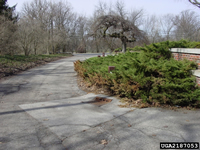
Figure 23A |

Figure 23B |
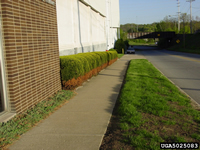
Figure 23C |
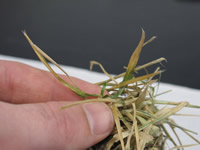
Figure 24A |
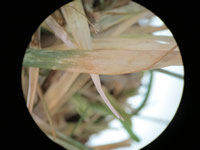
Figure 24B |
Air Pollution and Damaging Gases
Another example of chemical toxicity is damage from air pollutants. Several gaseous air pollutants can cause injury to plants, including ozone and sulfur dioxide. Ozone is produced when components of combustion/vehicle emissions such as hydrocarbons and nitrogen oxides react with oxygen and sunlight to form ground level ozone in the atmosphere. Its effects on plants can be mistaken for infectious diseases. Ozone can cause flecking (Figure 25A), which could be mistaken for mite injury. Ozone can also cause bronzing, chlorosis (Figure 25B), and necrosis. Necrosis could be mistaken for a leaf spot caused by an infectious agent. In conifers, injury can include needle-banding and tip-burn (Figure 25C). Air pollution levels are often available from local weather reports.
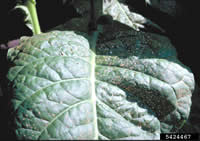
Figure 25A |
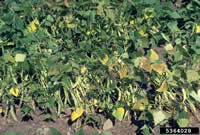
Figure 25B |
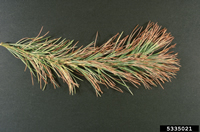
Figure 25C |
Ethylene gas, another air pollutant, can build up in closed production areas such as greenhouses. Ethylene is a plant hormone that is utilized to signal ripening and senescing within plant tissues. In most cases, the source of ethylene is a byproduct of incomplete combustion of fossil fuels in faulty greenhouse heating systems. It is colorless and odorless, making it difficult to detect and diagnose. Symptoms are variable, depending on the host species, host age, the ethylene concentration, and duration of exposure. Symptoms can include curled leaves, flower abortion, distorted/twisted stems, leaf and petal abscission, and stunting (Figure 26). These symptoms can be mistaken for viral infection or herbicide injury. Tomatoes, peppers, and vinca are particularly susceptible and may be the first species to show symptoms in a greenhouse. In some plants, at least some damage occurs with ethylene levels as low as 0.01 to 0.1 ppm. Concentrations of 1-10 ppm cause major damage or even plant death. In greenhouses, heating equipment and burners should be inspected and serviced annually for leaks or other problems.
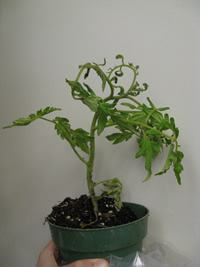 Figure 26
Figure 26 Mechanical Injury
Mechanical damage comes in many forms such as storms, misuse of equipment, or animal activity. Most of this type of injury is linked to a specific event, and symptom expression can generally be traced back to the time of the event. Symptoms of broken limbs, flattened tree tops or torn bark on tree trunks are easy indicators of mechanical damage. However, subtle symptoms of a general decline can develop when the root system is affected. Mechanical injury can cause opens wounds on plants that can be used as points of entry for pathogens, lead to a slow decline, or kill them outright.
Storm Damage
Storms that produce high winds, heavy snow or ice loads can result in significant limb breakage. It is common to see major limbs break and fall from numerous species that tend to break when ice storms deposit a thick coating of ice on trees (Figure 27A-C). High winds can knock down trees that have been predisposed to damage by root and butt rots or wood decay in the lower portion of the tree. Hail damage is common in any given year and is easy to discern on woody plants because the damage tends to show up on the same plane of the trunk and branches. Tattered leaves are also a symptom of hail damage. Lightning strikes produce a range of effects, from long narrow bands of dead tissue that run the entire tree length, to shattered wood or bark blown off the trunk (Figure 28A-B). Some trees are killed outright, while others recover from the damage and survive for many years. Tornado activity can flatten trees, blow them over, rip out major limbs and even blow the bark off the trunk. Proper pruning to remove torn limbs and good care after the storm event may help trees recover from minor damage. Trees with significant damage should be removed.
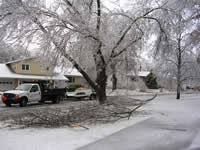
Figure 27A |
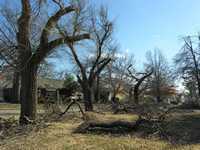
Figure 27B |
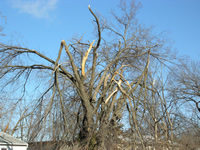
Figure 27C |
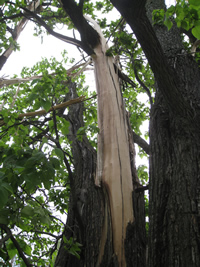
Figure 28A |
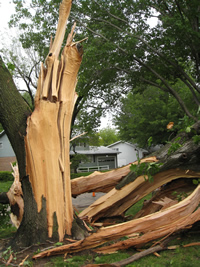
Figure 28B |
Equipment Injury
Human-inflicted damage can have a lasting effect on tree vigor. Lawn mowers, weed trimmers, or improper pruning with hedge trimmers or chainsaws can gouge, rip or split the trunk or limbs. Mower damage is a very common type of mechanical injury to landscape trees (Figure 29A-B). Wounded areas can serve as infection courts (opening used by pathogens to enter a host) for microbial pathogens or insect pests that can cause cankers or wood decay problems. Creating a barrier around the tree with mulch or a ground cover will help to reduce mower damage.
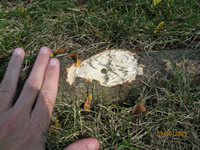
Figure 29A |
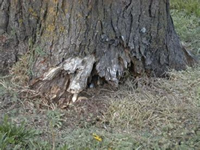
Figure 29B |
Heavy equipment used in the area of trees and landscape plants can result in compacted soils, reducing oxygen to the root systems and leading to a slow decline of the tree. Excavation to install sidewalks, irrigation systems or utility lines has a more direct impact by severing a portion of the root system (Figure 30A-C). Corresponding branch dieback may show up on the same side of the tree on which the root system was damaged. Young trees and shrubs may die or decline within a season or two, while older trees may struggle and decline over a period of many years.
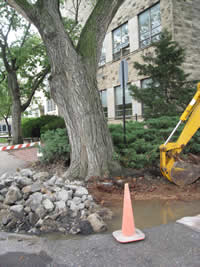
Figure 30A |
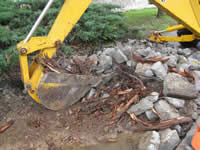
Figure 30B |
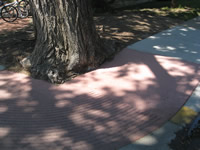
Figure 30C |
Damage due to Girdling
Girdling from guy wires, string, trunk wraps, vines or roots have a similar impact as equipment injury (Figures 31A-B). Pressure or constriction of the bark may collapse phloem tissue and sometimes xylem tissue. The long-term impact of girdling is that fewer photosynthates go to the root system. This leads to the development of a smaller root system with less potential for water and nutrient uptake. Over time, affected trees tend to be smaller than normal, have poor leaf emergence and are less vigorous. Recovery from this type of injury is difficult.
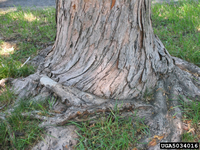
Figure 31A |
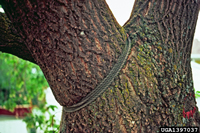
Figure 31B |
Animal Damage
Although not technically "abiotic", damage by mammals and birds is included here as another example of injuries that could be confused with disease symptoms. In addition, animal damage can predispose plants to diseases by weakening the plant and providing entry points for pathogens through wounds. Feeding by insects and arthropods is important to overall plant health but is not covered here.
During cold winters with abundant snowfall, voles and rabbits will feed on shrubs and young or thin-barked trees. Small plants can be clipped off at the height of the snow pack and extensive feeding can result in girdling and death of the plant. Habitat modification, protective barriers, and live-trapping are the best options for managing this type of damage.
Animals such as porcupines and squirrels can damage trees by removing bark (Figure 32A-B). Small twigs that have been clipped may be visible on the ground. In urban landscape trees, squirrel damage is minimal in most years. During stressful years, however, squirrels can strip enough bark to cause branch dieback in the tree. Individual trees can be protected by placing a 2-foot-wide collar of metal hardware cloth located about 6 feet off the ground. Live-traps can also be used to remove squirrels.
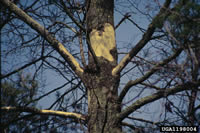
Figure 32A |
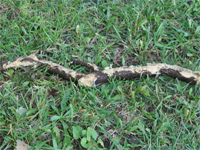
Figure 32B |
Deer browse on buds and young stems as they feed which can result in a bushy appearance of some plants. This may affect the aesthetic quality of the plant. More damaging are male deer that cause extensive limb breakage when they rub the velvet from their antlers. This damage can permanently disfigure and weaken trees. Fencing and repellants are the primary management strategies for preventing this type of injury. Deer also feed on many agronomic and horticultural crop plants and can be a nuisance for many farmers.
On tree trunks, multiple holes in a straight line, oriented either vertically or horizontally, are indicative of sapsucker damage (Figure 32C). Yellow-bellied sapsuckers are in the woodpecker family. As with other woodpeckers, they feed on insects, but their brush-like tongue allows them to feed on tree sap as well. Sapsuckers feed on many ornamental and fruit tree species, including pine, maple, birch, hemlock, Atlas cedar, mountain ash, as well as cherry and apple. Heavily damaged trees will be less vigorous and more prone to environmental stress, disease and insect problems. Yellow-bellied sapsuckers are protected by both state and federal law under the Migratory Bird Treaty Act, so it is illegal to kill them. Using barriers, repellants or scare tactics may help to reduce their feeding activity.
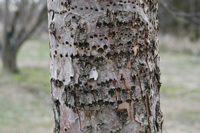 Figure 32C
Figure 32C Unusual Plant Growths
Other symptoms that can be mistaken for plant diseases but are actually abiotic in origin are variegated plants, sloughing bark and odd growths. Plants that are propagated because they have variegated leaves are very common in the horticultural industry. For example, variegated hostas are commonly planted in many gardens. The white tissue in the leaves of these plants lacks chlorophyll. This condition is the result of a genetic mutation. These plants are generally produced vegetatively because the trait is not stable through the process of typical seed production. Variegated plants tend to be smaller than their solid green counterparts because they produce less chlorophyll.
In trees, bark that is unusually rough or that separates from the wood may be of concern. If this is a new event, then concern is probably warranted. If the tree loses its bark every year then this is more likely a normal occurrence. Sycamore trees tend to slough their bark off in early summer following a period of rapid growth. Sometimes the bark gradually falls off and sometimes appears to blow off within a couple of days (Figure 33A). This process is normal and does not affect the health of the tree.
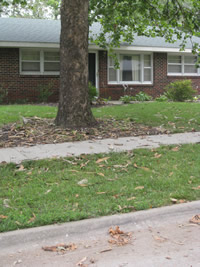 Figure 33A
Figure 33A Bumpy bark, burls, and other odd plant growths often look like symptoms of infectious diseases. However, burls, lignotubers and other growths on trees are usually the result of an injury. Burls frequently can be small or grow to a very large size (Figure 33B). The bark covers the burl and remains intact rather than appearing cracked or sunken. Lignotubers frequently hold a cluster of buds that sprout rapidly in the spring. These gnarled growths look odd but they don't seem to have a major impact on the health of the tree.
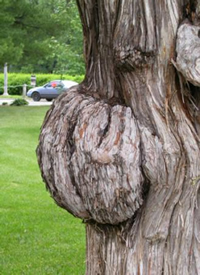 Figure 33B
Figure 33B Conclusions
Any time a plant health problem is encountered, an accurate diagnosis should be made because this has major implications for plant management. A plant with necrotic leaf margins may be assumed to have a fungal blight, but the true cause may be abiotic, potentially leading to an inappropriate use of fungicides. The importance of diagnosis and many tips for diagnosing plant problems are covered in another lesson which can be accessed at the following APS Education Center website:
https://www.apsnet.org/edcenter/disimpactmngmnt/casestudies/Pages/PlantDiseaseDiagnosis.aspx
When a plant shows symptoms of decline or abnormal growth, both abiotic and biotic causes should be considered. If biotic diseases are ruled out, a systematic view of the situation should be taken. Ask many questions about possible abiotic effects. Factors to consider include:
-
Identify and understand the plant. It is important to correctly identify the affected plant (or plants) and understand the climate, soil type, and management practices that are appropriate. Find out the species and cultivar if possible. Make sure you are familiar with the normal growth pattern of the plant.
-
Observe patterns in space and time. Biotic diseases tend to start in one area and progress over time (i.e., diseases are infectious and chronic). Many abiotic issues tend to NOT progress in space and time. They may occur all at once, due to a singular event such as an herbicide misapplication or cold snap. Abiotic issues may follow a regular pattern such as along roadway, in certain rows of a crop, etc., whereas biotic diseases tend to be random.
-
Observe which species are affected. Infectious diseases tend to have a narrow host range, such as a particular species, genus, or family. There are exceptions, however, such as diseases caused by
Botrytis or tomato spotted wilt virus, which affect many hosts. In general, abiotic issues are more likely to be the cause if multiple, unrelated species are showing symptoms.
-
Be skeptical of secondary invaders. As with biotic diseases, after an abiotic disorder has weakened or killed plant tissue, secondary colonizers may exploit the tissue. Don't let secondary colonizers cause you to overlook the primary cause.
-
Consider multiple problems. Several problems can occur together. For example, saturated soils may weaken roots, and subsequent dry weather can result in rapid decline in some plant species. Winter damage can predispose plants to cankers.
-
Investigate weather patterns. Is the site exposed to strong winds? Are the winds from one or two primary directions? Is the site shaded or sunny? Are affected plants on a north-facing slope (shady) or south-facing slope (sunny/dry).
-
Analyze plant nutrient status. When was the last soil test? What were the results? Should a new test be ordered? Should any specialized micronutrient tests be conducted? Has a leaf tissue analysis been performed?
-
Look for drainage and compaction. Are there low areas where water could pool? Are there any other indications of a potential drainage problem? Is the soil heavy (high clay content)?
-
Check for irrigation problems. Is the site irrigated? How is the frequency and amount of irrigation determined? Is the irrigation system working? What is the water source? Has water quality been tested?
-
Get a chemical use history. Which fungicides, insecticides, herbicides, fertilizers have been applied? When, how, and at what rate? Are de-icing salts or other chemicals used at or near the site?
-
Determine the construction/excavation history. Has there been any construction in the past 5 years? Has soil been removed or added?
Abiotic stressors cause symptoms in plants that are similar to or the same as symptoms of diseases caused by infectious agents. Abiotic stressors can also predispose plants to pathogens and have been linked to several biotic diseases in crop and ornamental plants. Understanding abiotic disorders is critical for managing overall plant health.
Selected References
American Phytopathological Society – Compendium of Plant Diseases and Pests. APS publishes a series of diagnostic compendia for various crops. Most compendia include information and images about abiotic disorders as well as biotic diseases. For more information and ordering, see: http://my.apsnet.org/APSStore/Category?Category=Compendium
Bennett, W. 1993. Nutrient Deficiencies and Toxicities in Crop Plants. APS Press. St. Paul, MN. 202 pp.
Costello, L. R., Perry, E. J., Matheny, N. P., Henry, J. M., Geisel, P. M. 2003. Abiotic Disorders of Landscape Plants: A Diagnostic Guide. University of California Agriculture and Natural Resources Publication 3420. Oakland, CA. 242 pp.
Flagler, R. B. 1998. Recognition of Air Pollution Injury to Vegetation: A Pictorial Atlas. Air & Waste Management Association. Pittsburgh, PA.
Fry, J., and Huang, B. 2004. Applied Turfgrass Science and Physiology. John Wiley & Sons. Hoboken, NJ. 310 pp.
Gibson, J. L., Pitchay, D. S., Williams-Rhodes, A. L., Whipker, B. E., Nelson, P. V., and Dole, J. M. 2007. Nutrient Deficiencies in Bedding Plants: A Pictorial Guide for Identification and Correction. Ball Publishing. Batavia, IL. 369 pp.
Gibson, J. L., Whipker, B. E., Blankenship, S., Boyette, M., Creswell, T., Miles, J., Peet, M. 2000. Ethylene: Sources, symptoms, and prevention for greenhouse crops. North Carolina State University, Horticulture Information Leaflet 30. Raleigh, NC. https://content.ces.ncsu.edu/ethylene-sources-symptoms-and-prevention-for-greenhouse-crops
Hartman, J. R., Pirone, T. P., and Sall, M. A. 2000. Pirone's Tree Maintenance. 7th ed. Oxford University Press. New York, NY. 560 pp.
Lloyd, J. 1997. Plant Health Care for Woody Ornamentals: A Professional's Guide to Preventing and Managing Environmental Stresses and Pests. University of Illinois College of Agricultural, Consumer and Environmental Sciences. Champaign, IL. 223 pp.
Malinoski, M. K., and Clement, D. L. 2009. Broadleaved Shrubs and Shade trees: Problems, Picture Clues and Management Options. Natural Resource, Agriculture and Engineering Service (NRAES) publication 183. Ithaca, NY. 186 pp.
Nordby, D., Wiesbrook, M., and Bretthauer, S. 2007. Field Guide to Herbicide Injury on Landscape Plants. University of Illinois Extension IPM. 112 pp.
Turgeon, A. J., McCarty, L. B., Christians, N. 2009. Weed Control in Turf and Ornamentals. 1st edition. Pearson Education, Inc. Upper Saddle River, NJ. 300 pp.
Whipker, B. E., and Evans, M. R. 2012. Regulation of plant growth. Pages 373-389 in: Greenhouse Operation and Management. P. V. Nelson, ed., 7th Edition. Pearson Prentice Hall. Upper Saddle River, NJ. 607 pp.
